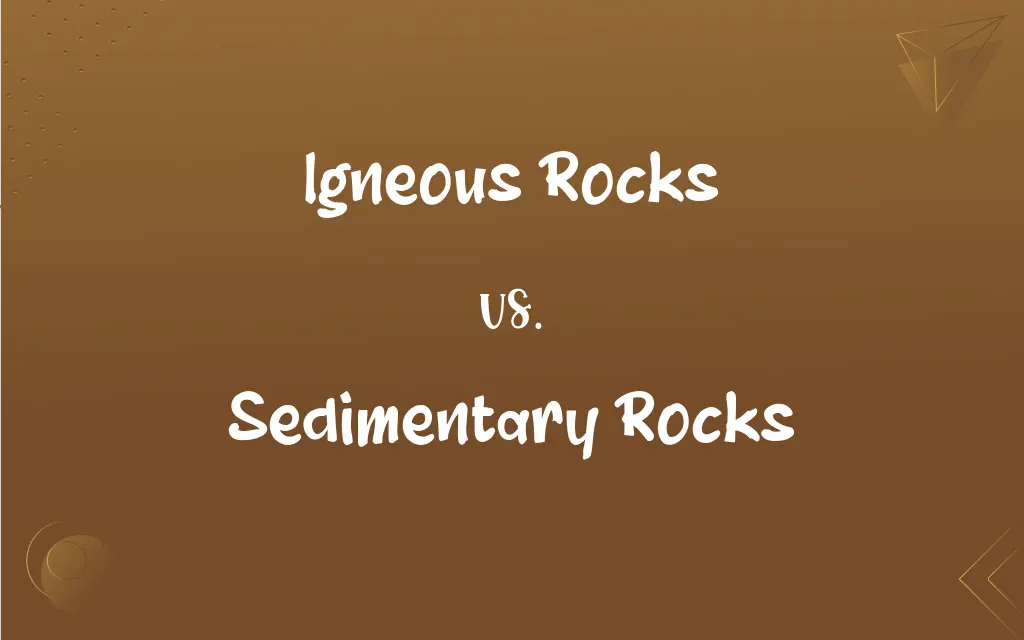Igneous Rocks vs. Sedimentary Rocks: What's the Difference?
Edited by Aimie Carlson || By Janet White || Published on November 9, 2024
Igneous rocks form from cooled magma or lava, featuring crystalline textures, while sedimentary rocks are formed from sediment compaction and cementation, often layered and containing fossils.

Key Differences
Igneous rocks originate from the solidification of molten magma or lava, characterized by a crystalline structure and often containing minerals like quartz and feldspar. In contrast, sedimentary rocks are formed from the accumulation and cementation of sediment, which can include fragments of other rocks, minerals, and organic material, leading to a typically layered appearance.
The formation of igneous rocks occurs either beneath the Earth's surface as intrusive rocks or on the surface as extrusive rocks, resulting from volcanic activity. Sedimentary rocks, however, are shaped by processes of weathering, erosion, deposition, and lithification, often found in layers that can reveal Earth's history.
Igneous rocks, such as granite and basalt, are generally hard, dense, and resistant to weathering due to their interlocking crystal structures. Sedimentary rocks like sandstone and shale are usually less dense, can be brittle, and often display visible layers or strata.
In igneous rocks, the cooling rate of magma or lava determines the crystal size, with slower cooling leading to larger crystals. Sedimentary rocks often contain fossils and can provide significant information about past environments and life on Earth, something rarely found in igneous rocks.
Igneous rocks typically lack the stratification seen in sedimentary rocks, instead showing a more uniform and homogenous composition. In contrast, sedimentary rocks can feature a variety of textures, from fine-grained clays to larger, rounded gravels, indicative of the environment of their formation.
ADVERTISEMENT
Comparison Chart
Origin
Cooled magma or lava
Compacted and cemented sediment
Texture
Crystalline, often homogeneous
Layered, varied textures
Common Locations
Volcanic areas, beneath Earth's surface
River beds, oceans, deserts
Density and Hardness
Generally dense and hard
Often less dense, can be brittle
Presence of Fossils
Rare
Common, especially in certain types
ADVERTISEMENT
Igneous Rocks and Sedimentary Rocks Definitions
Igneous Rocks
Rocks formed from the solidification of magma or lava.
The granite countertop in the kitchen is made of an igneous rock.
Sedimentary Rocks
Include clastic, chemical, and organic types based on composition.
Coal, an organic sedimentary rock, is formed from compressed plant material.
Igneous Rocks
Crystalline solids formed beneath or on the Earth's surface.
Basalt, an igneous rock, is commonly found in volcanic regions.
Sedimentary Rocks
Rocks formed by the deposition and cementation of sediment.
The cliffs along the river are composed of layers of sedimentary rock.
Igneous Rocks
Rocks characterized by interlocking crystals of minerals.
Obsidian, a type of igneous rock, has a glassy texture and sharp edges.
Sedimentary Rocks
Often contain fossils and are formed in layers.
Limestone, a sedimentary rock, frequently contains marine fossils.
Igneous Rocks
Include both intrusive and extrusive types, based on formation location.
Diorite is an intrusive igneous rock, forming deep within the Earth.
Sedimentary Rocks
Formed from particles of other rocks, minerals, and organic matter.
Sandstone is a sedimentary rock formed from compacted sand.
Igneous Rocks
Formed through the cooling and solidification of molten material.
Pumice, an igneous rock, is so light that it can float on water.
Sedimentary Rocks
Display a variety of textures, indicating different environmental conditions.
Shale, a fine-grained sedimentary rock, forms in calm water environments.
FAQs
Are igneous rocks usually hard?
Yes, igneous rocks are generally hard and dense due to their crystalline structure.
How are sedimentary rocks formed?
Sedimentary rocks are formed from the compaction and cementation of sediments.
What defines an igneous rock?
Igneous rocks are formed from cooled and solidified magma or lava.
Can sedimentary rocks contain fossils?
Yes, sedimentary rocks often contain fossils.
What causes the layering in sedimentary rocks?
Layering is caused by the deposition of sediment over time.
What textures do sedimentary rocks have?
Sedimentary rocks can have varied textures, from fine-grained to coarse.
What environments form sedimentary rocks?
They form in various environments like rivers, oceans, and deserts.
What are examples of igneous rocks?
Examples include granite, basalt, and obsidian.
Can sedimentary rocks tell us about Earth's history?
Yes, their layers can reveal information about past environments.
Are sedimentary rocks used in construction?
Yes, some types, like limestone, are commonly used in construction.
What minerals are common in igneous rocks?
Quartz, feldspar, and mica are common minerals.
Are igneous rocks formed quickly or slowly?
The formation rate can vary; slower cooling leads to larger crystals.
What is the difference in formation locations for igneous rocks?
They form either beneath (intrusive) or on (extrusive) the Earth's surface.
How do sedimentary rocks contribute to geological studies?
They provide insights into sedimentation processes and past life.
Do igneous rocks have crystals?
Yes, igneous rocks often have a crystalline texture.
Can igneous rocks be porous?
Some, like pumice, are porous, but many are not.
What role do volcanoes play in forming igneous rocks?
Volcanoes erupt magma that cools to form igneous rocks.
Is coal a sedimentary rock?
Yes, coal is an organic sedimentary rock.
Can igneous rocks be found everywhere on Earth?
They are widespread, especially in volcanic and tectonic areas.
Do sedimentary rocks form under high pressure?
They often form under relatively low pressure but over long periods.
About Author
Written by
Janet WhiteJanet White has been an esteemed writer and blogger for Difference Wiki. Holding a Master's degree in Science and Medical Journalism from the prestigious Boston University, she has consistently demonstrated her expertise and passion for her field. When she's not immersed in her work, Janet relishes her time exercising, delving into a good book, and cherishing moments with friends and family.
Edited by
Aimie CarlsonAimie Carlson, holding a master's degree in English literature, is a fervent English language enthusiast. She lends her writing talents to Difference Wiki, a prominent website that specializes in comparisons, offering readers insightful analyses that both captivate and inform.







































































